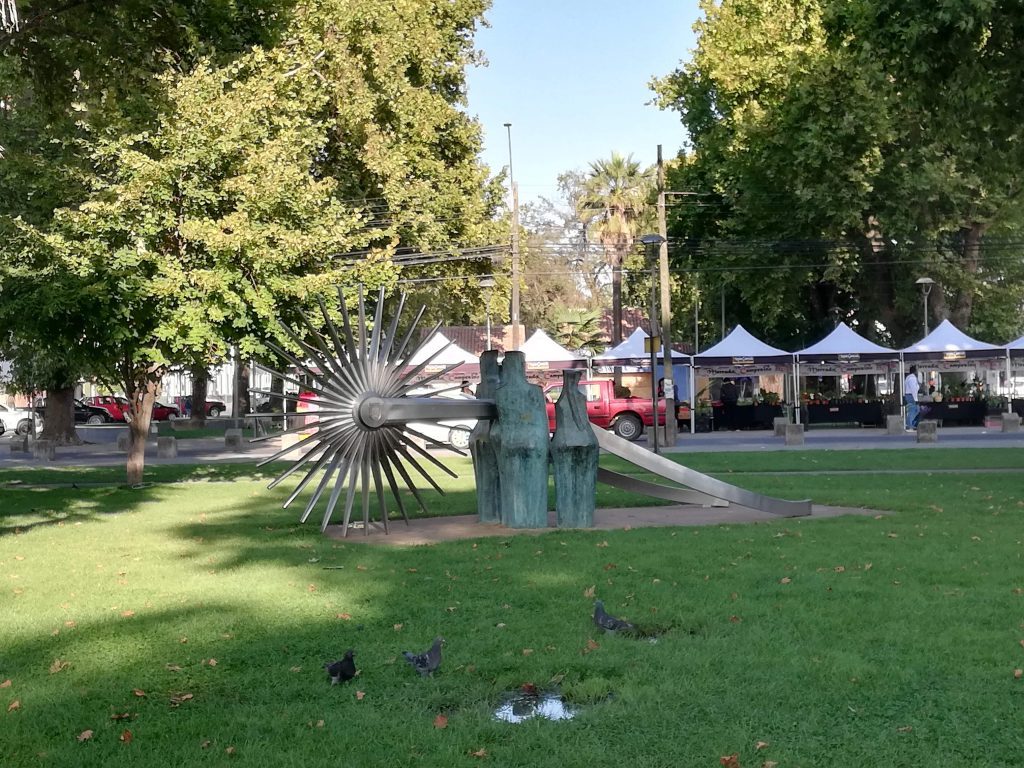To get to our Aguapiedras cabins, you have to pass through Linares, this will be the last city on your way, and you better buy all your groceries here, take out cash from ATM, fill your tank with fuel, and in general get ready for your trip, buy everything you might need.
Linares is the third-largest city in the Maule Region, in the Chilean Central Valley. The commune of Linares has 93.000 inhabitants (Census 2017) and it is the capital of the Linares Province. It is located 300 kilometers (186 miles) south of Santiago and 100 kilometers (62 miles) north of Chillán.
How to get to Linares
Linares is located 300 kilometers south of Santiago and the easiest way to get there is by car or bus by Route 5, or by train from Santiago or Chillán. The closest national airport is in Concepción, 222 kilometers (138 miles) away from Linares.
Services
Linares has all the basic services: communal and provincial government, most public offices, a hospital, other medical centers, banks, supermarkets, post offices, and all kinds of shops, restaurants, and bars.
Important historical facts
Linares was founded by Ambrosio O’Higgins, the father of General Bernardo O’Higgins, in 1794, by the name of Villa San Ambrosio de Linares.
The city was the site of the first event that led to the independence of Chile, when on April 6, 1813, the Plaza de Armas was taken by General Bernardo O’Higgins (During the era of The Chilean War of Independence).
What to see and do in Linares
Plaza de Armas (Main Square)

As in most Chilean cities, the Plaza de Armas is surrounded by the most important streets of the city. In Linares, these are called Independencia, O’Higgins, Kurt Moller, and Manuel Rodríguez streets. In various spots on the square, there is an odeon, a fountain, the monuments to Carlos Ibáñez del Campo, Carrera, Prat, O`Higgins, and the clock tower. Large trees grow in the plaza, ensuring shade in the summer months.
Around the Plaza, you can find the Cathedral, the Provincial Government, the Library and the Municipality of Linares. Usually, Plaza de Armas is full of people: just walking around or resting on the benches. Many social gatherings start on the Plaza, fairs and other activities are regularly organized there.
Cathedral of San Ambrosio de Linares

On the Plaza de Armas, we can find the Cathedral of San Ambrosio de Linares, built between 1935 and 1937. The design of the cathedral is based on the Basilica of San Ambrosio, in Milan, Italy. The Cathedral was built after the structure of the old cathedral was demolished after irreparable damage caused by the Talca earthquake of 1928.
Corazón de María de Linares Church
Translation of the name is The Heart of Mary´s Church. The Corazón de María de Linares church was declared a National Historic Monument in 1995 through Supreme Decree No. 677. The construction presents two architectural styles: Gothic and romantic style and inside there are 17 stained glass windows with religious scenes. The church is made up of three naves: the main nave and two lateral ones, and these house 3 altars brought from Europe.
After the 2010 earthquake, the church was seriously damaged: one of its side towers broke and leaned inward. Inside, a large part of the images and paintings were damaged, but the image of the Virgen del Corazón (Virgin of the Heart) remained intact. Until now the church remains closed to the public.
La Alameda

The original meaning of the word Alameda is “two rows of poplar trees that make a street or a walk”, the street is still called Alameda by locals, but the official name is Valentin Letelier street.
The formation of the first Alameda Valentín Letelier began in 1843 and was formed by poplars, which remained until 1889 when they were cut and replaced by holm oaks. Between 1932 and 1933 the oaks were cut and Oriental planes were planted instead, these trees remain until now.
Alameda stretches for 5 blocks from the Liceo Valentin Letelier (high school) to San Martín Street. There is a public amphitheater at the eastern end of the Alameda. The Alameda is used for family walks, games, different fairs are set up here during the year. During the warm months, you can sit in one of the street stands that sell Chilean traditional dessert called “mote con huesillo”. According to Wikipedia mote con huesillo is “a traditional Chilean summertime drink often sold in street stands or vendor carts. It is a non-alcoholic beverage consisting of a sweet clear nectar-like liquid made with dried peaches cooked in sugar, water and cinnamon, and then once cooled, mixed with fresh cooked husked wheat.”
Linares Museum of Arts and Crafts

Linares Museum of Art and Crafts, founded in 1962 with private donations from various Chilean artists, was installed in a colonial house located in the Alameda (address: Valentín Letelier 572). The Municipality of Linares bought the house for the museum. The collection has more than 3,000 pieces distributed in five collections: popular art and crafts, visual arts, history, archeology, and numismatics.
Precordillera de Linares (Linares mountains)
Precordillera in Spanish means the hills and mountains lying before The Andes mountain range. The mountains of Linares are the usual destination of many locals (Linarenses) and not locals either to spend the summer or to take shorter trips throughout the year. One of the main sectors they visit is the Achibueno River Nature Sanctuary, with its towns such as Pejerrey. To stay in the Precordillera there are a variety of accommodations mostly in cabins. This area is often called the Patagonia of Central Chile for its stunning nature.

If you visit Linares, you should definitely find the time to explore the surrounding nature and mountains, come to swim in the Achibueno River, and lodge in our Aguapiedras cabins!